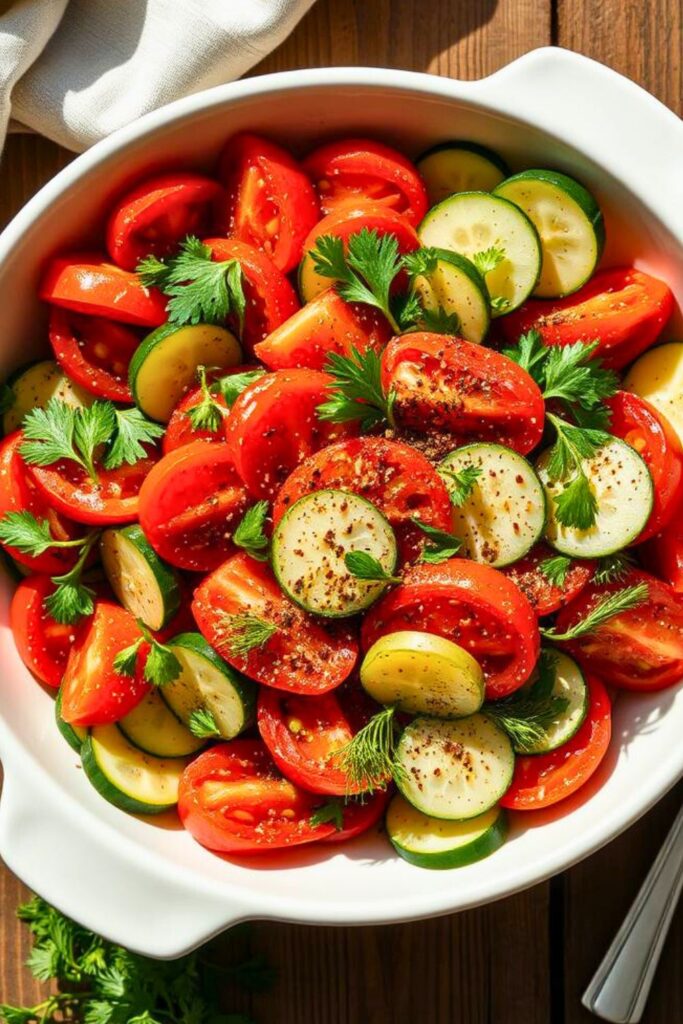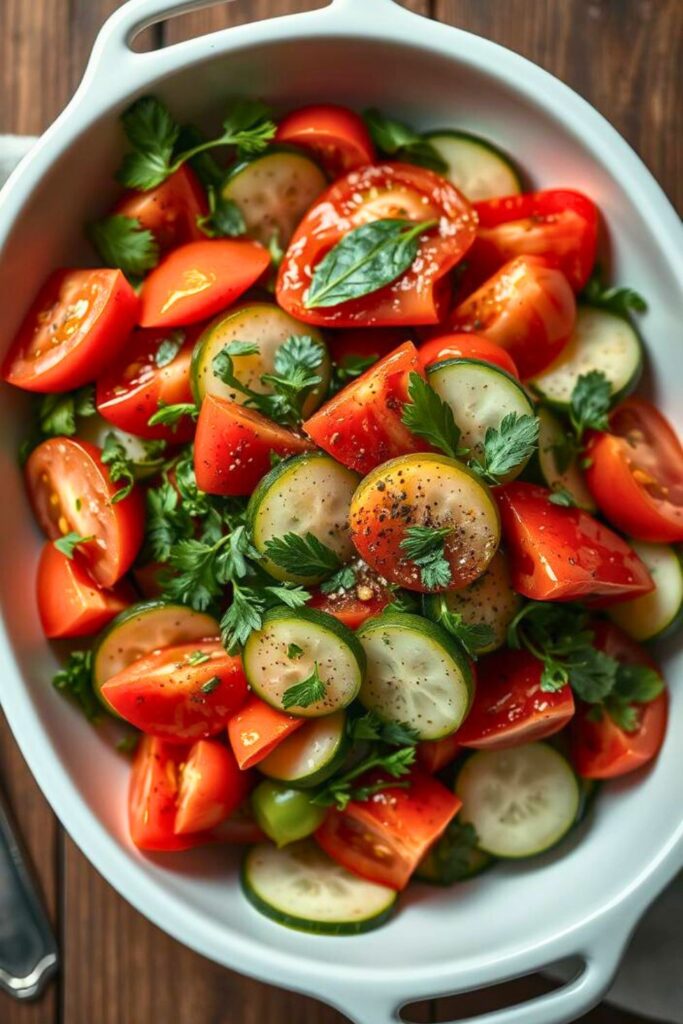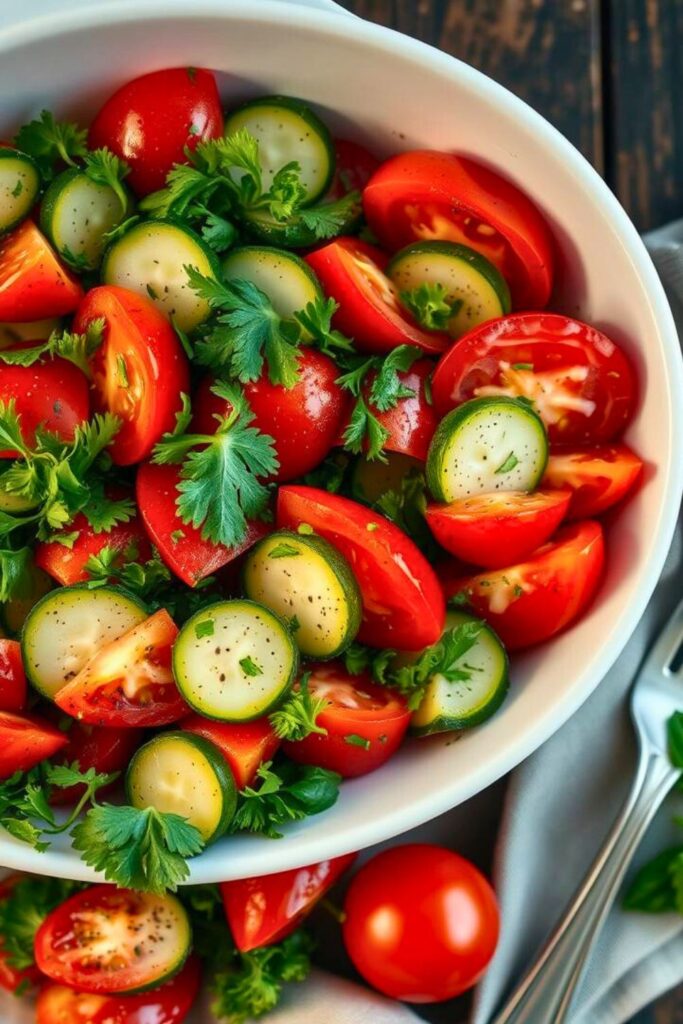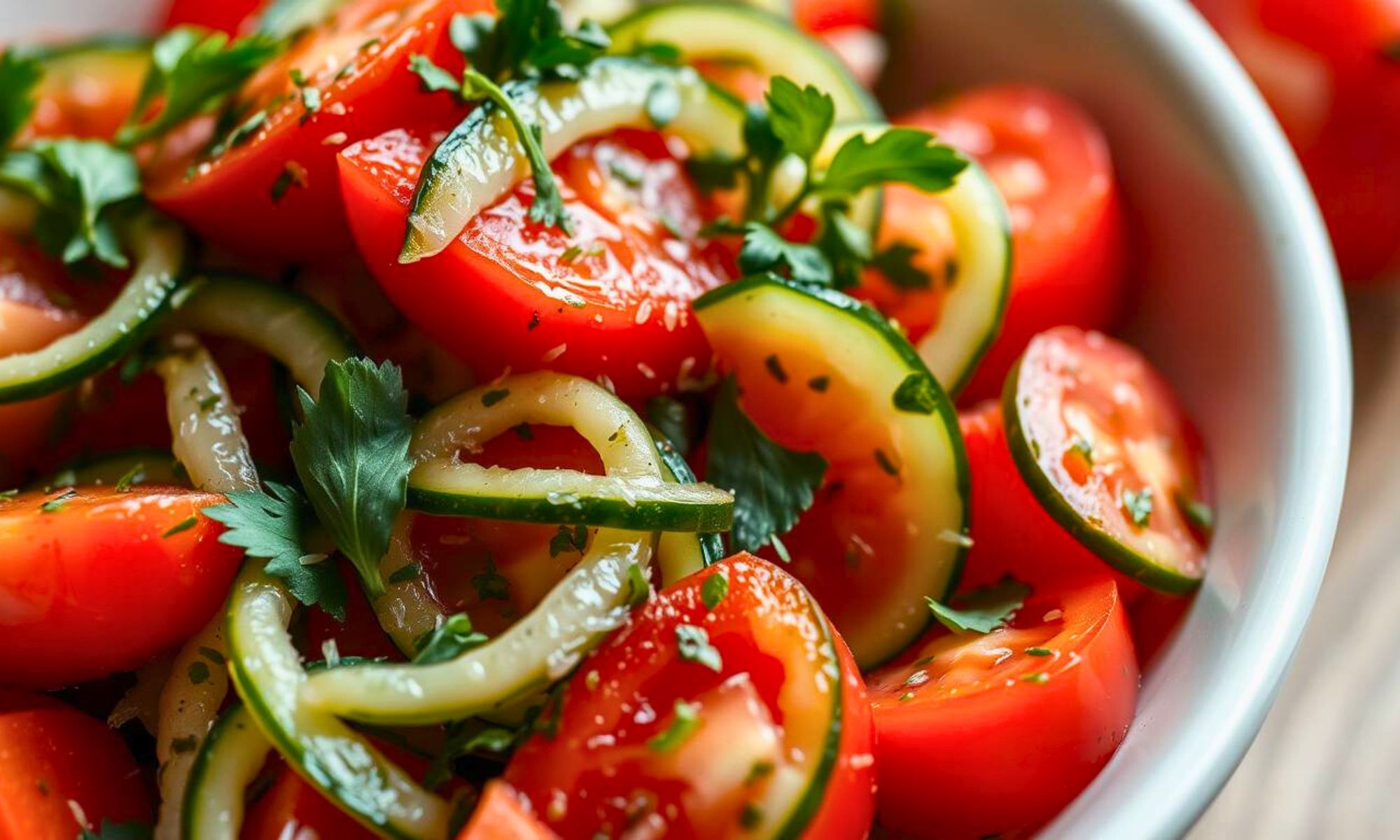Picture this: you’re standing in your kitchen at 6 PM on a Tuesday, staring into your fridge like it might magically produce dinner inspiration. There’s a bag of cucumbers getting a little soft, some tomatoes that need using up, and honestly? You’re too tired for anything complicated.
But here’s what I learned from my Greek neighbor Sofia last summer – the most extraordinary dishes come from ordinary moments. Her tomato cucumber salad changed everything I thought I knew about simple cooking. This isn’t your typical “chop and toss” situation. We’re talking about a dish that transforms humble ingredients into something that makes people ask for the recipe.
Let me tell you exactly why this tomato cucumber salad deserves a permanent spot in your summer rotation. It’s not just about throwing vegetables together and calling it a day. There’s technique here, friends. Real technique that’ll make your taste buds dance.
Why This Salad Changes Everything
You know that feeling when you bite into something and suddenly understand why people write poetry about food? That’s what happens here. The secret isn’t just in what you put in – it’s in how you treat each ingredient like it matters.
Most people think salad is boring. They’re not wrong about most salads. But when you understand how salt draws moisture from cucumbers, or how acid makes tomatoes taste more tomatoey, everything changes.
This dish taught me that simple doesn’t mean basic. It means you’ve stripped away everything unnecessary until only perfect flavors remain.
The Real Story Behind Perfect Ingredients

What You’ll Actually Need
Let’s talk ingredients how you’ll actually use them – in order that makes sense when you’re prepping:
4 oz feta cheese (optional—but highly recommended)
4 large cucumbers (Persian or English – fewer seeds, less water)
6 ripe tomatoes (Roma or heirloom preferred)
1 large red onion (or sweet onion if you prefer less bite)
1/2 cup extra virgin olive oil (don’t go cheap here)
1/4 cup red wine vinegar (white wine vinegar works too)
2 tbsp fresh lemon juice (fresh matters)
1 tsp kosher salt (plus more for salting cucumbers)
1/2 tsp black pepper (freshly ground is best)
1/4 cup fresh dill (or 1 tbsp dried, added to dressing)
1/4 cup flat-leaf parsley
Smart Swaps That Actually Work
No Persian cucumbers? Use regular ones—just peel, seed, and slice.
No red wine vinegar? Apple cider vinegar is tangy and delicious.
Hate raw onions? Soak them in cold water for 15 minutes to soften the bite.
No fresh herbs? Use dried—but add only one-third the amount and mix into the dressing first to let the flavor bloom
The Ingredient Whisperer’s Secrets
Here’s what most people don’t know about picking tomatoes: smell the stem end. Good tomatoes smell like summer – green and sweet together. No smell? No flavor.
Cucumbers should feel heavy for their size. Light ones are hollow inside, and that’s not what we want. Give them a gentle squeeze – they should feel firm but not rock hard.
The olive oil matters more than you think. You’re not cooking with it, so every flavor comes through. Get something you’d actually dip bread into.
Step-by-Step Magic (The Real Process)
Step 1: The Cucumber Game-Changer
This is where most people mess up, and it’s the difference between good salad and one that makes people remember your name.
Slice your cucumbers into rounds about 1/4 inch thick. Now here’s the magic – lay them out on a big plate or baking sheet and sprinkle them generously with salt. Not just a pinch. Really salt them.
Let them sit for 30 minutes. I know, I know. Who has time? But this draws out excess water that would otherwise make your salad soggy and sad. Trust the process.
After 30 minutes, you’ll see pools of water around the cucumbers. Pat them dry with paper towels. Really dry. This step is everything.
Step 2: Tomato Prep That Matters
While your cucumbers do their thing, prep your tomatoes. Cut them into wedges – not too thin, because they’ll fall apart, but not so thick they’re awkward to eat.
Here’s what Sofia taught me: sprinkle cut tomatoes with just a tiny bit of salt too. Not as much as the cucumbers, but enough to wake up their flavors. Five minutes is all they need.
Step 3: The Dressing That Brings It All Together
In a small bowl, whisk together olive oil, vinegar, and lemon juice. Add salt and pepper. This is your base, but here’s where it gets interesting.
Finely chop your herbs – and I mean finely. Big chunks of dill overpower everything else. Add them to dressing and let it sit while you finish the rest.
Step 4: Assembly Like a Pro
Slice your onion thin. Really thin. If you’re crying, you’re doing it right. If you soaked them earlier, drain them well.
In your largest bowl, combine dried cucumbers, tomatoes, and onions. Pour dressing over everything and toss gently. You’re not making a smoothie here – treat those tomatoes with respect.
If you’re using feta, crumble it over the top now. Don’t mix it in too much or it’ll get mushy.
Common Pitfalls and How to Dodge Them
Don’t skip the cucumber salting step. I see you thinking about it. Don’t do it. Soggy salad is nobody’s friend.
Go too heavy on onions and they’ll take over completely. Start with less – you can always add more, but you can’t take them out.
Making this ahead? Keep dressing separate until you’re ready to serve. Dressed salad sits overnight and you’ve got tomato soup, not salad.
The Science Behind the Sizzle

Why Salt Makes Cucumbers Better
When you salt cucumbers, you start osmosis. Salt draws out water trapped in cucumber’s cells, concentrating flavor and creating that perfect crisp texture we’re after.
This isn’t just about texture though. Removing excess water means your dressing can actually cling to cucumber instead of sliding off. It’s the difference between flavored vegetables and a properly dressed salad.
The Acid Factor
Vinegar and lemon juice aren’t just for tang – they’re actually brightening all other flavors. Acid makes tomatoes taste more tomatoey, makes herbs pop, and helps cut through olive oil’s richness.
There’s also food science happening with feta. Acid in dressing helps break down proteins just slightly, making cheese creamier and helping it integrate better with other ingredients.
Cultural Roots and Modern Twists
This style of salad has roots in Greek horiatiki, but every Mediterranean country has their version. Bulgarians add roasted peppers. Turks might throw in some sumac. The beauty is in how adaptable it is.
What makes this version special is how it borrows best techniques from all these traditions. Cucumber salting from Greeks, herb-forward dressing from Turks, generous use of good olive oil from Italians.
Making It Beautiful and Delicious
Presentation That Impresses
Serve this in a shallow, wide bowl rather than deep one. It shows off all colors and makes it easier for people to see what they’re getting.
Right before serving, give it one more gentle toss. Add a few whole herb leaves on top – it’s a small touch that makes a big difference.
If you’re feeling fancy, drizzle just a little extra olive oil around bowl’s edge. It catches light and makes everything look more intentional.
Perfect Pairings
This salad plays well with grilled everything. Chicken, lamb, fish, even grilled halloumi if you’re going full Mediterranean. Cool, crisp vegetables cut through rich, smoky flavors like magic.
For drinks, think crisp white wines – Sauvignon Blanc, Pinot Grigio, or even dry rosé. If you’re not drinking, try it with sparkling water with a splash of lemon.
It’s also incredible alongside warm pita bread and some hummus. Suddenly you’ve got a whole mezze situation happening, and nobody’s complaining about that.
Making It Your Own
Variations Worth Trying
Once you’ve mastered basic technique, the world opens up. Try adding roasted red peppers for sweetness and color. Kalamata olives bring briny depth that’s pretty amazing.
In late summer, throw in some fresh corn kernels. Sounds weird, tastes incredible. Sweetness plays beautifully with acid and herbs.
Want more protein? Chickpeas turn this into a proper meal. So does leftover grilled chicken or even some canned tuna.
Seasonal Adaptations
Spring version: add radishes and use more parsley than dill. Summer’s classic time, but don’t sleep on fall tomatoes with some toasted walnuts mixed in.
Winter? This probably isn’t your salad season, but hothouse tomatoes and cucumbers can still work if you’re craving something fresh and bright.
The Perfect Tomato Cucumber Salad

What makes this recipe worth your time isn’t just that it tastes good – though it definitely does. It’s that it teaches you techniques you’ll use forever. Cucumber salting trick alone will change how you think about vegetables.
This salad gets better as it sits for first hour or two. Flavors meld, herbs release their oils, and everything becomes more than the sum of its parts. Just don’t let it sit too long or you’ll lose that perfect textural contrast.
The best part? Once you understand basic technique, you can riff on it endlessly. Different herbs, different acids, different additions – but always with that foundation of properly prepared cucumbers and good ingredients treated with respect.
Make this once and you’ll understand why simple food done right beats complicated food done wrong every single time.
Frequently Asked Questions
Can I make this salad ahead of time?
You can prep all components ahead, but don’t dress the salad until you’re ready to serve. Cucumbers stay crisp for about 2 hours after salting and drying, so time it accordingly. If you must make it completely ahead, it’s still good next day, just different – more of a gazpacho-style situation.
What if I can’t find Persian cucumbers?
Regular cucumbers work fine with a little extra prep. Peel them completely and slice them lengthwise. Use a spoon to scrape out seeds and any soft, watery flesh. Then slice and salt as directed. You might need an extra 10 minutes of salting time since regular cucumbers hold more water.
My tomatoes aren’t very flavorful. Any tricks?
Salt them more generously and let them sit longer – up to 15 minutes. Salt will concentrate whatever flavor they have. Also, make sure they’re at room temperature, not cold from fridge. Cold tomatoes taste like nothing. If they’re really bland, a tiny pinch of sugar can help, but use it sparingly

Swiftly Captions by Tina Smith — Quick, flavorful food recipes made simple, bringing fresh inspiration to your kitchen every day






